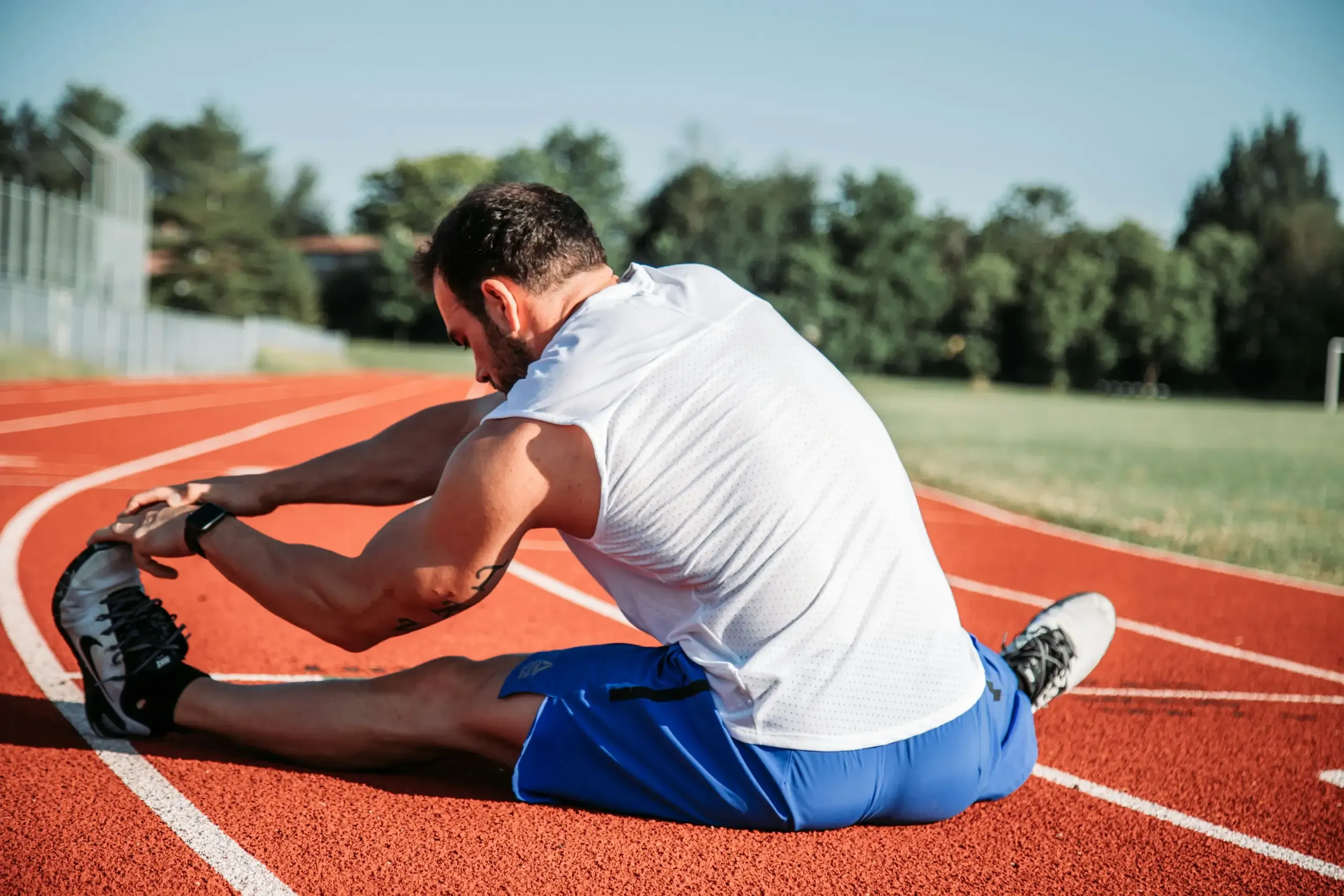So you've crushed your workout. Don't just drop the weights and head for the shower. The next 5-10 minutes are just as crucial as the workout itself. The goal here is simple: gradually bring your heart rate back down to earth with some light activity, then ease into some static stretches to help your muscles relax and recover.
A basic cooldown is a two-part process. First, think gentle movement - a slow walk or a light spin on the bike. Then, hold your stretches for 15-30 seconds each. This simple routine is your best defense against feeling dizzy post-workout and waking up with that dreaded next-day stiffness.
Preventing Post-Workout Soreness
We've all been there - that "good sore" feeling the day after a workout. While it’s a sign of progress, a smart cooldown can significantly reduce the intensity of Delayed Onset Muscle Soreness (DOMS). It immediately kickstarts the recovery process by helping to clear out metabolic byproducts, like lactic acid, that build up in your muscles.
Just a five-minute walk followed by a few targeted stretches gives your muscles the signal to relax and begin repairing. You'd be surprised what a massive difference this small investment of time makes in how you feel 24 hours later.
By allowing your heart rate and breathing to return to normal gradually, you place less stress on your heart and help your body transition smoothly from a state of work to a state of rest.
It doesn’t matter if you're a lifelong athlete or just learning how to start working out, building a cooldown into your routine is non-negotiable. It’s not an add-on; it's a fundamental part of staying healthy, preventing injuries, and making consistent progress.
Your Blueprint for an Effective Cooldown Stretch
A proper cooldown isn't just about flopping onto a mat and pulling on your leg for a few seconds. Think of it as a structured conversation with your body, a way to signal that the hard work is done and it's time to start the recovery process. The best approach I've found over the years involves two distinct phases that gently guide your body from high gear back down to neutral.
First, you need to transition. Don't just slam on the brakes after your last rep or final sprint. Instead, spend three to five minutes on some light dynamic movement. This could be a slow walk, some easy pedaling on a bike, or even just some gentle arm circles. The point is to keep the blood moving, which helps clear out metabolic waste and prevents that dizzy feeling you can get from stopping abruptly.
Mastering Static Stretches for Recovery
Once your heart rate has had a chance to come down, it's time for phase two: static stretching. This is the classic "hold-it-right-there" stretching most people picture. Now you’re focusing on releasing all that tension that built up in your muscles during the workout.
The key is to target the specific muscle groups you just hammered. Hold each stretch for a solid 20-30 seconds. That's the magic number that tells your muscle's stretch reflex to chill out and actually lengthen. Whatever you do, don't bounce. Bouncing can actually make the muscle tighten up as a protective measure, which is the exact opposite of what you want. Just breathe into it.
A good static stretch is about finding that point of tension - not pain - and just holding. This sustained hold is what really boosts blood flow to the muscle fibers, kickstarting the repair process and helping you feel less like a rusty tin man the next day.
Essential Post-Workout Cooldown Stretches
To help you build a well-rounded routine, here's a quick-reference guide covering some of the most effective cooldown stretches. This card outlines which muscles you're targeting and how long to hold each position for the best results.
Essential Post-Workout Cooldown Stretches

Standing Quadriceps Stretch
Quadriceps & Hip Flexors. Hold 20-30 seconds per side.

Doorway Chest Stretch
Pectorals & Shoulders. Hold 20-30 seconds.

Child Pose
Lats, Back & Shoulders. Hold 30-60 seconds.

Standing Hamstring Stretch
Hamstrings & Calves. Hold 20-30 seconds per side.

Cross-Body Shoulder Stretch
Deltoids & Upper Back. Hold 20-30 seconds per side.
Mixing and matching these stretches based on your workout will ensure you're giving your body a comprehensive and effective cooldown every single time.
Fueling Up for Faster Muscle Repair
Your cooldown doesn't really end when you finish your last stretch. The final, and arguably most important, part happens in the kitchen. What you eat and drink right after a workout makes all the difference in how fast you bounce back. It's a simple one-two punch: rehydrate and refuel.
First, let's talk about hydration. It's not just about chugging water until you're not thirsty anymore. When you sweat, you lose more than just water; you're also losing critical electrolytes like sodium and potassium. These are the minerals that keep your muscles firing correctly and prevent cramping. You have to replace them to get your body back in balance.
What to Eat After a Workout
Next up is refueling, and this is where we get into the "anabolic window" idea. While the science now shows this window isn't as narrow as we once thought, it's still a great practice to eat within an hour or two after your workout. This is when your muscles are primed and ready to soak up nutrients.
Your body is craving two main things at this point:
- Protein: This is for repair. It provides the amino acids needed to patch up the tiny tears in your muscle fibers from the workout. Think of it as the raw material for rebuilding.
- Carbohydrates: These are for restocking. Carbs replenish your muscle glycogen stores, which is the primary fuel you just burned through.
Combining protein and carbs is far more effective than having either one on its own. The carbohydrates actually help transport the protein into your muscle cells more efficiently, kickstarting the repair process so you're good to go for your next workout.
Recovery shakes offer a convenient option, with an ideal protein-to-carb ratio of approximately 1:2 or 1:3. Whey protein is recommended due to its rapid digestion. However, real food should not be overlooked, as a balanced meal or snack can be equally effective. For ideas on post-workout recovery foods, explore our lit of the best post-workout recovery foods.
Using Your Breath to Calm Your Nervous System
When you finish a tough workout, your body is buzzing. It's in a full-on "fight or flight" state, flooded with stress hormones like cortisol and adrenaline. To really get the recovery process started, you need to deliberately shift gears into a "rest and digest" mode.
And the fastest way to do that? Your breath. It’s the most powerful tool you have.
Controlled, deep breathing is like sending a direct message to your brain that the hard part is over and it's time to chill out. This simple act physically lowers your heart rate, eases your blood pressure, and tells your entire body it’s safe to start repairing. It's a foundational piece of how to cool down after workout that connects what's happening in your head with what your muscles are feeling.
Your Top Cooldown Questions, Answered
Even when you know the basics, real-world situations bring up questions. Let's clear up some of the common points of confusion so you can nail your cooldown every time.
How Long Should I Really Spend Cooling Down?
The sweet spot for most workouts is 5 to 10 minutes. This gives you enough time to let your heart rate settle back to normal and hit a few key stretches without feeling like you're just going through the motions.
But if you’ve just pushed yourself through something intense - think a long-distance run or a new personal record on your deadlift - you'll feel the difference if you can stretch that out to 15 minutes. Your body will thank you for the extra attention.
What if I’m Totally Strapped for Time?
We've all been there. You're running late, and the idea of skipping the cooldown is tempting. But even a few minutes is infinitely better than nothing.
If you only have three minutes to spare, don't just stop. Spend one minute walking slowly to let your heart rate come down gently. Then, use the next two minutes to stretch the main muscles you just hammered. Just finished a leg day? Hit a quick quad and hamstring stretch. That's it.
The most important thing is to avoid a sudden stop. A short, focused cooldown is always better than skipping it and letting blood pool in your limbs, which can leave you feeling dizzy.
Can I Just Take a Cold Shower Instead?
A cold shower feels amazing after a tough workout, but it doesn't do the same job as an active cooldown. It’s a completely different tool for recovery.
Your muscles need that period of light movement and stretching to help flush out metabolic byproducts and gradually return to a resting state. A cold shower is fantastic for taming inflammation, but it's something you should do after you’ve finished your active cooldown routine. Think of it as a bonus recovery step, not a replacement.

